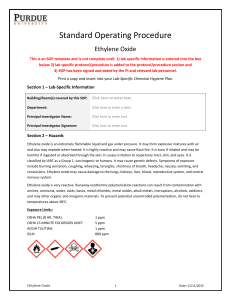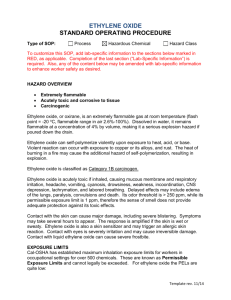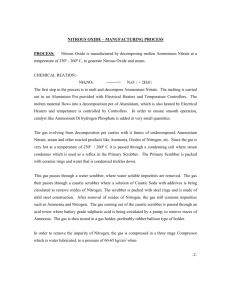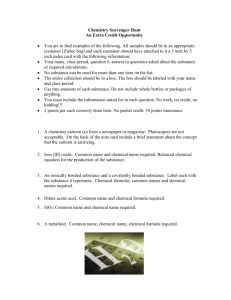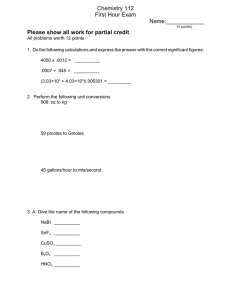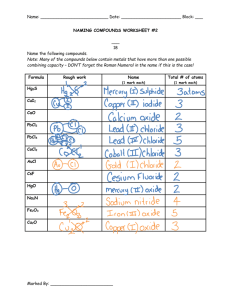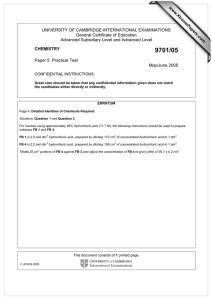Document 14246190
advertisement
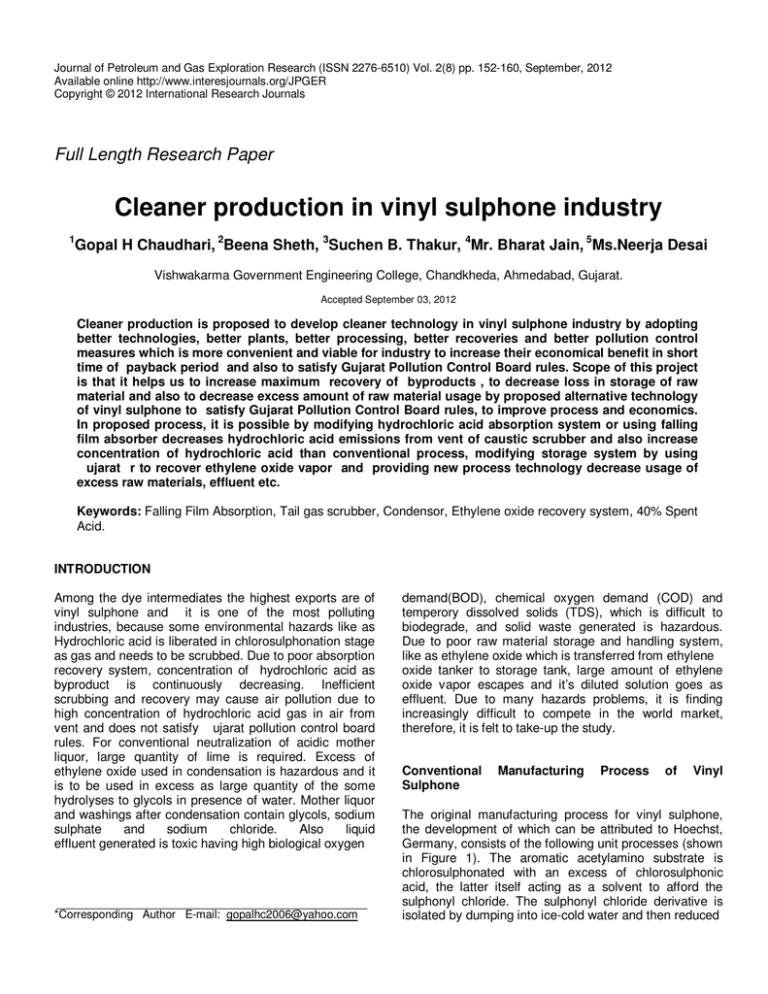
Journal of Petroleum and Gas Exploration Research (ISSN 2276-6510) Vol. 2(8) pp. 152-160, September, 2012 Available online http://www.interesjournals.org/JPGER Copyright © 2012 International Research Journals Full Length Research Paper Cleaner production in vinyl sulphone industry 1 Gopal H Chaudhari, 2Beena Sheth, 3Suchen B. Thakur, 4Mr. Bharat Jain, 5Ms.Neerja Desai Vishwakarma Government Engineering College, Chandkheda, Ahmedabad, Gujarat. Accepted September 03, 2012 Cleaner production is proposed to develop cleaner technology in vinyl sulphone industry by adopting better technologies, better plants, better processing, better recoveries and better pollution control measures which is more convenient and viable for industry to increase their economical benefit in short time of payback period and also to satisfy Gujarat Pollution Control Board rules. Scope of this project is that it helps us to increase maximum recovery of byproducts , to decrease loss in storage of raw material and also to decrease excess amount of raw material usage by proposed alternative technology of vinyl sulphone to satisfy Gujarat Pollution Control Board rules, to improve process and economics. In proposed process, it is possible by modifying hydrochloric acid absorption system or using falling film absorber decreases hydrochloric acid emissions from vent of caustic scrubber and also increase concentration of hydrochloric acid than conventional process, modifying storage system by using ujarat r to recover ethylene oxide vapor and providing new process technology decrease usage of excess raw materials, effluent etc. Keywords: Falling Film Absorption, Tail gas scrubber, Condensor, Ethylene oxide recovery system, 40% Spent Acid. INTRODUCTION Among the dye intermediates the highest exports are of vinyl sulphone and it is one of the most polluting industries, because some environmental hazards like as Hydrochloric acid is liberated in chlorosulphonation stage as gas and needs to be scrubbed. Due to poor absorption recovery system, concentration of hydrochloric acid as byproduct is continuously decreasing. Inefficient scrubbing and recovery may cause air pollution due to high concentration of hydrochloric acid gas in air from vent and does not satisfy ujarat pollution control board rules. For conventional neutralization of acidic mother liquor, large quantity of lime is required. Excess of ethylene oxide used in condensation is hazardous and it is to be used in excess as large quantity of the some hydrolyses to glycols in presence of water. Mother liquor and washings after condensation contain glycols, sodium sulphate and sodium chloride. Also liquid effluent generated is toxic having high biological oxygen *Corresponding Author E-mail: gopalhc2006@yahoo.com demand(BOD), chemical oxygen demand (COD) and temperory dissolved solids (TDS), which is difficult to biodegrade, and solid waste generated is hazardous. Due to poor raw material storage and handling system, like as ethylene oxide which is transferred from ethylene oxide tanker to storage tank, large amount of ethylene oxide vapor escapes and it’s diluted solution goes as effluent. Due to many hazards problems, it is finding increasingly difficult to compete in the world market, therefore, it is felt to take-up the study. Conventional Sulphone Manufacturing Process of Vinyl The original manufacturing process for vinyl sulphone, the development of which can be attributed to Hoechst, Germany, consists of the following unit processes (shown in Figure 1). The aromatic acetylamino substrate is chlorosulphonated with an excess of chlorosulphonic acid, the latter itself acting as a solvent to afford the sulphonyl chloride. The sulphonyl chloride derivative is isolated by dumping into ice-cold water and then reduced Chaudhari et al. 153 Figure 1. Process flow diagram of vinyl sulphone. Figure 2. Conventional Hydrochloric acid Absorption System. with alkaline sodium bisulphite to the corresponding sulphonic acid. The sulphonic acid derivative is then condensed with ethylene oxide in presence of sulphuric acid to give β-hydroxyethylsuIphone. Heating the sulphone with concentrated sulphuric acid brings about sulphation andhydrolysis to yield βsulphatoethylsulphone derivatives, which are marketed as such. Sources of Emissions i) Hydrochloric acid (HCl) emission chiorosulphonation and drowning step. ii) Acetic acid and water vapour emission esterification step. from from iii) Pulveriser air emission containing vinyl sulphone dust. Current Methods For Recovery And Treatment of Hydrochloric Acid Emissions Hydrochloric acid gas is emitted from chlorosulphonation and drowning step is scrubbed with water in packed bed scrubbers (shown in Figure 2). Hydrochloric acid solution is re-circulated by pump until it gets concentrated. Hydrochloric acid solution can be sold, if it is 30%. As the concentration of hydrochloric acid increases, recovery efficiency decreases. Packed bed scrubbers are not properly designed to provide effective surface area for absorption. No suction is provided for the gas. Packed columns are not properly cleaned and maintained. 154 J. Pet. Gas Explor. Res. Figure 3. Sample Procedure For Unloading With Inert Gas Nitrogen. Figure 4. Ethylene Oxide Storage Tank (Capacity 10 tonne). N2inlet E.O.Outlet Figure 5. Transfer of E.O. Recovery efficiency of hydrochloric acid is about 90%. Disadvantages of Conventional hydrochloric acid Absorption System/Problem Formulation. 1) Poor design of scrubber. 2) Do not satisfy Gujarat pollution control board norms due to high concentration of HCl gas (more than 20 ppm) in vent from caustic scrubber. 3) HCl is circulated in single scrubber, it’s maximum concentration is 25%-30%, and it continuously decreases recovery and efficiency of scrubber. Continuous make up of water is required. 4) High consumption of caustic in caustic scrubber increases quantity of effluent. Storage/Unloading System of Ethylene Oxide Before transfer ethylene oxide liquid from E.O. storage tanker to storage tank, first to check pressure, temperature and cooling system of E.O. storage tank (shown in Figure 3). If pressure in storage tank and storage tanker 4 kg/cm2, then open the nitrogen outlet valve (PR 2) of storage tank (shown in Figure 3) to release the pressure of nitrogen. Generally pressure of 2 E.O. storage tank is 3 kg/cm and temperature is 10°C when it is filled in it. So that, due to high pressure in storage tanker of E.O., it is transferred to the storage tank without any addition of nitrogen in tanker. When pressure in both storage tank and tanker is equal, then to add extra nitrogen from nitrogen cylinder (shown in Figure 7) to tanker (shown in Figure 4 and 5). So nitrogen is Chaudhari et al. 155 Figure 6. Top View of E.O. Figure 7. N2 cylinder. Figure 8. Loss of Ethylene Oxide in Water During Tansfer From Storage Tanker to Storage Tank. pressurized E.O. liquid. Pressure of nitrogen cylinder is maximum 200–250 psi (14 kg/cm2). When N2 transfer to tanker, at that time pressure is between 3 to 4 2 kg/cm .(Figure 6) tanker is 100 kg and 300 kg in winter – monsoon and summer (shown in Table 1). Proposed Manufacturing Process Of Vinyl Sulphone Problem Formulation During Transfer Ethylene Oxide From Ethylene Oxide Tanker To Storage Tank i) N2 is filled in O2 cylinder. As per GPCB norms it is more dangerous for industry, because if O2 comes in contact with E.O., then explosion may occur. ii) When E.O. is transferred from E.O. tanker to storage tank, the pressure is increased in storage tank. To reduced pressure, N2 valve is to be open.So, N2 along with E.O Vapor escape from storage tank . This N2 – E.O. Vapor is directly dilute with water (shown in Figure 8). So that E.O. gets dilute in water and produce ethylene glycol. Ethylene glycol is more toxic and difficult to treat by conventional methods Loss of ethelyne oxide per tanker is 100 kg and 300 kg in winter – monsoon and Chlorosulphonic acid is taken in M.S. jacketed reactor and cooled to 10°C. Acetanilide is added slowly with agitation and cooling, maintaining the temperature at 10°C. Then the temperature is raised to 55°C by passin steam through the jacket, and maintained at 55°C for 4 hours. The completion of reaction is checked by caustic solubility test. Liberated hydrochloric acid gas is sent to HCl absorption system (Figure 9,10 and 11). The reaction mass is cooled to 10°C. The cooled reaction mass is drained to jacketed glass contactor, in which it is continuously contacted with cooled 40% sulphuric acid, maintaining the temperature below 20°C. Liberated hydrochloric acid is sent to HCI scrubbing system. The reaction mass is drowned in an agitated mild steel glass lined drowning vessel in which ice water is taken. The vessel is cooled externally also to maintain temperature 156 J. Pet. Gas Explor. Res. Table 1. Loss of Ethylene Oxide. Loss of Ethelyne Oxide/Tanker/month in winter or monsoon. 100 Kg/Tanker Loss of Ethelyne Oxide/Tanker/month in summer. 300 Kg/Tanker Loss of Ethelyne Oxide/10Tanker /month in winter or monsoon. Loss of Ethylene Oxide/10Tanker /month in summer. Loss of Ethylene Oxide/6 months in winter and monsoon. Loss of Ethylene Oxide/4 months in summer. 1000 Kg/10 Tanker Total Loss Rs/annum 3000 Kg/10Tanker 8000 Rs/tanker /month 24000 Rs/tanker /month 80000 Rs/10Tanker /month 6000 Kg/6 months 240000 Rs/10Tanker/ month 480000 Rs/6 months 12000 Kg/4 months 960000 Rs/4 months - 1440000 Rs/annum in Figure 9. Proposed Process Flow Diagram of Vinyl Sulphone. Chaudhari et al. 157 Figure 10. Proposed Process Flow Diagram of HCl Recovery. Figure 11. Falling Film Absorber. at 10°C. This vessel also is connected to HCl absorption system. Acetanilide sulphonyl chloride (ASC) slurry is pumped to a pressure filter for filtering ASC. ASC cake is thoroughly washed with chilled water at 10°C in the pressure filter. Filtrated and washings are collected and sent for recovery of sulphanilic acid and spent acid. ASC cake is scraped and transfer to reduction reactor. Aqueous solution of sodium bisulphite is taken in jac- 158 J. Pet. Gas Explor. Res. keted stainless steel reduction reactor, to which ASC wet cake is added. Caustic lye is added simultaneously controlling the resulting pH at 7.0. Then it is heated to 55°C and 48 maintained for 4 hours. The reaction mass is clarified by passing over a filter press coated with filter air. Clarified reaction mass is taken in condensation reactor. Filter cake is washed, removed and sent for disposal. Sodium salt of sulphanilic acid taken in jacketed stainless steel condensation reactor is maintained at 55°C. Ethylene oxide gas is passed at a controlled rate taking all necessary precautions. pH is controlled at 7.00 by addition of 40% sulphuric acid. The reaction mass is then cooled to 20°C. The reaction mass is filtered through a closed filter cum dryer where precipitated acetanilide hydorxy ethyl sulphone (AHES) is filtered, washed with water and dried. Filtrate and washings are collected and sent for glauber salt recovery. Dried AHES is transferred to sulphation reactor. AHES is taken in stainless steel sulphation reactor specially designed for sold handling. 100% sulphuric acid (monohydrate) is added and the reaction mass is heated to 170°C and maintained. Acetic acid vapours are sent to condenser for recovery of acetic acid. Acetic acid evolution is stopped when the reaction is complete. The end of reaction is confirmed by TLC. The product is discharged and taken in a pulveriser. Pulveriser is fitted with elaborate dust collection system. pulverised vinyl sulphone is packed. Proposed Methods For Recovery And Treatment Of HCl Emissions Proposed absorption system for HCl gas is shown in Figure 10. HCl gas evolved in chlorosulphonation reactor, sulphuric acid contactor and drowning vessel is passed through two packed bed scrubbers in series. (shown in Figure 10) Concentration of HCl is allowed to rise upto 30% in the first scrubber with re-circulation and then it is sent for sale. HCl acid solution from the second absorber, which is about 10% concentration, is then taken for circulation in the first column. Fresh water is taken in the second column. If any quantity of unabsorbed HCI gas escapes the second column, it is scrubbed in the third column by caustic soda solution. Scrubber solution at the third column is sent to effluent treatment, when the strength of caustic soda solution fall below 3% wt/wt. The exit gas is analysed for traces of HCl. New Technological Option For HCl Recovery by Using Falling Film Absorber Advantages (1) It satisfy GPCB norms by also decreases ppm of HCl in vent less than 50 ppm . (2) Concentration of HCl from falling film absorber is 35% - 37% while the same from adiabatic packed tower ranges from 25% to 30% .(shown in Figure 11) (3) Absorption is more efficient in falling film absorber for the given absorption duty. (4) Falling film absorber requires less space compared to adiabatic packed tower type absorber. (5) Other advantages of falling film absorber are lower temperatures, lower pressure drops and higher efficiency. (6) Consumption of caustic in caustic scrubber for neutralization almost negligible. Disadvantages (1) More difficult to control and is sensitive to liquid and gas distribute on problems. (2) It has greater tendency to absorb undesirable water soluble low boiling impurities. Proposed Ethelyne Oxide Recovery Systen By Using Pump With Condensor Without Using Inert Gas (1) Check pressure, temperature, inventory of storage vessel, and all pipe line-ups before unloading the EO railcar. While unloading, system pressure always remains in the inert region as determined by railcar and storage vessel temperatures (Figure 12 can be used as a guide for sites to establish minimum pressure(s) for unloading operations and onsite storage). (2) Open liquid valves A, D, E, G (3) Close liquid valve C (4) Open vapor valves B, F (5) Check that the transfer pump is properly primed and not vapor bound Design Specification of Condensor For Recovery of Ethelyne Oxide Vapour Escapes With Nitrogen From Storage Tank Problem Nitrogen saturated with ethelyne oxide vapour at 2.5 2 kg/cm and at 11°C temperature is to be sent to shell and tube heat exchanger for recovering ethelyne oxide. Nitrogen – Ethelyne oxide vapour mixture is to be cooled to 10°C by chilled brine as a ethylene glycol which enters at -20°C and leaves the heat exchanger at -18°C. Type of Heat Exchanger : BEM as per TEMA SS - 304 Shell ID = 180 mm Tube length = 2000 mm Tube ID = 15.748 mm Chaudhari et al. 159 Figure 12. Sample Procedure For Unloading With Transfer Pump. Table 2. Quantitative Comparison Conventional And Proposed Process. SR NO (1) (2) (3) (4) (5) (6) Consumption of main raw materials Acetanilide Chlorosulphonic acid Sodium Bisulphite Caustic Soda Ethylene oxide Sulphuric acid Of Consumption Conventional Process In Kg 3000 13500 1849 2133 1300 835 Tube OD = 19.05 mm Tube pitch = 25.04 mm Type of tube pitch arrangement = Triangular Number of tubes = 28 Number of tube side passes = 2 Number of shell side passes = 1 Baffle type = 25 % cut segmental Baffle spacing = 75 mm % Efficiency/Recovery = 66 – 70 % Cost Saving = 10 lakh Rs/annum PayBack Period = 6 months. Design Specification Of Centifugal Pump For Transfer E.O. Liquid From Storage Tanker to Tank and Also To Transfer Condensed Liquid From Condensor. Pump Type = MEGA 32 – 200 Nominal Speed = 2900 rpm Frequency = 50 Hz. Impeller Outlet width = 6 mm Impeller Diameter = 186 mm Pump Capacity = 10 m3/hr. Raw Material Between Proposed Process In Kg 2680 10965 1652 1917 874 835 Pressure = 4 kg/cm2 Head = 45 m (max) NPSH = 0.5 m Delivery Pipe Size = 32 mm Suction Pipe Size = 50 mm. Electric motor = 7.5 HP Powe Consumption = 5.5 kwatt Cost of Pump = 16000 Rs. Cost of 7.5 HP motor = 12000 Rs. Cost of Unit power consumption/hr = 28 Rs/hr Cost saving per annum = 1440000 Rs. Payback period = 6 months. RESULTS Table 2 and 3 CONCLUSION From above result, it is to be concluded that if chlorosulfonated mass after chlorosulphonation contact with 40% sulphuric acid, then negligible amount of hydro- 160 J. Pet. Gas Explor. Res. Table 3. Quantitative Comparison Of Effluent And Treatment For Vinyl Sulphone. Particulars Gaseous Hydrochloric Acid Generated Treatment Hydrochloric acid emitted from water scrubber Caustic Soda consumption in caustic scrubber Liquid Water Consumption (including ice) Waste Water generated Main Pollutants H2SO4 HCl Na2SO4 NaCl Glycols Conventional Process In Kg Proposed Process In Kg 811 2711 2711 Single Absorber Multiple absorber with tail gas scrubber Falling Film Absorber 81 27 Negligible Amount 127 42 Negligible Amount 94547 57215 1,06,940 68623 9178 730 3734 1040 775 10829 2440 3227 938 175 chloric acid goes into effluent. More quantity of hydrochloric acid is scrubbed by falling film absorber system than conventional process. So, consumption of caustic in caustic scrubber for neutralization of hydrochloric acid is negligible in falling film absorption system and decreases quantity of effluent. Condensor with centrifugal pump without using any inert gas is widely useful for recovery of ethelyne oxide vapor escapes with nitrogen from storage tanker and convert it into the liquid form about 66% to 70% for reuse.Total recovery of ehelyne oxide in terms of money is 10 lakh Rs. Total capital cost for installation of condenser and payback period are very less. From the above various technological options for hydrochloric acid absorption system, ethylene oxide recover system and to decrease excess raw materials by new technological routes, it is clear that liquid effluent, gaseous emissions which is generated in conventional process may be reduced or eliminated, The most advantage of this research work is to satisfy Gujarat pollution control board norms and do not create any environmental pollution by vinyl sulphone industries. REFERENCES Chemical and Petrochemicals Statistical at a Glance, Ministry of Chemicals and Fertilisers (2005 – 06), (2004 – 05). Ethylene Oxide Product Stewardship Guidance Manual 227, May 2007. Foster D Snell, Leslie S Ettre (1992). Encyclopedia of Industrial Chemical Analysis,Volume 12,14. Kirk Othmer (1965). Encyclopedia of Chemical Technology, Volume 5,8,22. Study of upgradation/development of alternative technologies for pollution control in vinyl sulphone industry (2007). Ministry of Environment and Forest, March. Thakore SB, Bhatt BI (2008). Introduction to Process Engineering and Design, Edition 1,Tata Mcgraw Hill, New Delhi, 110008. th Ullmann Encyclopedia of Industrial Chemistry (1967). 4 edition , Volume 8. th Ullmann Encyclopedia of Industrial Chemistry (1967). 6 edition , Volume 5,8,34,35. Venkataraman K (1990). Chemistry of synthetic dyes, volume 3,5.

